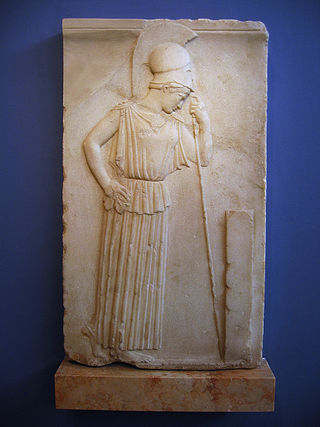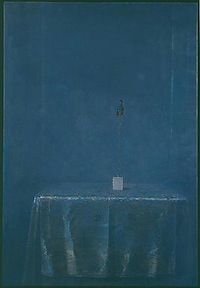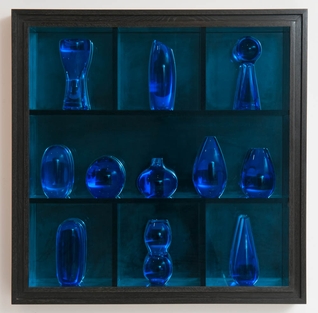
A peplos is a body-length garment established as typical attire for women in ancient Greece by c. 500 BC, during the late Archaic and Classical period. It was a long, rectangular cloth with the top edge folded down about halfway, so that what was the top of the rectangle was now draped below the waist, and the bottom of the rectangle was at the ankle. One side of the peplos could be left open, or pinned or sewn together, with a type of brooch later called "fibula". In Latin and in a Roman context, it could be called a palla.

Le Déjeuner sur l'herbe – originally titled Le Bain – is a large oil on canvas painting by Édouard Manet created in 1862 and 1863.

Christ in the House of His Parents (1849–50) is a painting by John Everett Millais depicting the Holy Family in Saint Joseph's carpentry workshop. The painting was extremely controversial when first exhibited, prompting many negative reviews, most notably one written by Charles Dickens. It catapulted the previously obscure Pre-Raphaelite Brotherhood to notoriety and was a major contributor to the debate about Realism in the arts. It is now in Tate Britain in London.

M. Louise Stowell a Rochester. NY-based Arts & Crafts artist was born on June 16, 1861, in Hornell, NY, to Thomas Stowell (1819–1896)—a fire insurance adjuster and special agent for Aetna—and Henrietta Fowler (1820–1902); they moved to Rochester, NY in 1884.

The Memorial Art Gallery is a civic art museum in Rochester, New York. Founded in 1913, it is part of the University of Rochester and occupies the southern half of the University's former Prince Street campus. It is a focal point of fine arts activity in the region and hosts the biennial Rochester-Finger Lakes Exhibition and the annual Clothesline Festival.

Miss La La at the Cirque Fernando is an oil on canvas painting by the French Impressionist artist Edgar Degas. Painted in 1879 and exhibited at the Fourth Impressionist Exhibition in Paris that same year, it is now in the collection of the National Gallery in London. It is Degas's only circus painting, and Miss La La is the only identifiable person of color in Degas's works. The special identity of Miss La La and the great skills Degas used in painting her performance in the circus made this piece of art important, widely appreciated but, at the same time, controversial.

Linn Meyers, known professionally as linn meyers, is a visual artist based in Washington, DC and Los Angeles. She is known for dense, intricate drawings, paintings, installations and prints that range in scale from page-sized images to large pieces on Mylar and panel to monumental, site-specific wall works. Her art is rooted in a process of repetitive drawing—thousands of hand-drawn marks that come together to form rhythmic, patterned wholes and serve as records of their own making. While ostensibly abstract, her works are also widely suggestive of natural phenomena and fundamental aspects of the universe, from fingerprints to galaxies, and cellular patterns to tidal waves. Curator Anne Ellegood observed, "She is after a purity of making—a physical process that does not hide behind illusionism—a directness wherein the materiality of the work is evident and … all the mystery is removed so that it is what it is."

Debra Bermingham is an American artist known for her interior scenes and still lifes.

Louise Upton Brumback was an American artist and art activist known principally for her landscapes and marine scenes. Her paintings won praise from the critics and art collectors of her time. Writing at the height of her career, a newspaper critic praised her "firmness of character, quick vision, and directness of purpose." She said these traits "proved a solid rock upon which to build up an independent art expression which soon showed to men painters that they had a formidable rival." As art activist, she supported and led organizations devoted to supporting the work of under-appreciated painters, particularly women.

Mother and Child (The Oval Mirror) is an oil-on-canvas painting by the American Impressionist artist Mary Cassatt. The painting depicts a mother and her child in front of a mirror. The painting provides a glimpse of the domestic life of a mother and her child, evoking religious iconography from the Italian Renaissance. However, portrayals of a mother and her child are common in Cassatt's work, so it is possible that this similarity is coincidental rather than intentional.

In 1635, Peter Paul Rubens created Venus and Adonis, now in the Metropolitan Museum of Art, New York. He followed the mythological story in the Metamorphoses by Ovid, inspired from his love of classical literature and earlier depictions of this scene. This oil on canvas painting shows Venus accompanied by Cupid, embracing and pulling Adonis before he goes off to hunt. The artist uses specific colors, detail and strong contrast between light and dark to depict a dramatic and emotional scene. At the time Rubens created the painting, the mythological story of Venus and Adonis was popular in Renaissance and Baroque court art. Rubens was clearly inspired by the many existing depictions of this scene, in particular the famous Titian composition of the same name, of which there are numerous versions. This depicts the same moment of Adonis leaving Venus to hunt, despite her pleas to stay. He is killed later in the day.

Averil Mary Burleigh born Averil Mary Dell was a British artist and painter. Based in Sussex, Burleigh was known for painting in egg tempera with the subject usually involving a central figure. Her husband and daughter also painted but she is the best regarded of the three.
Ronald Hayes Pearson was an American designer, jeweler, and metalsmith. He lived for many years in Rochester, New York and later, Deer Isle, Maine.
Ada Howe Kent was an American artist and philanthropist. She was a mentee of James Abbott McNeill Whistler and worked with M. Louise Stowell. She was a member of the American Watercolor Society and the Rochester Art Club. Kent also had a large collection of Japanese prints.

Blue Prism Painting I is a sculpture created by Josiah McElheny in 2014. Crafted out of blue glass, mirror, oak, and plywood, this sculpture is the first installment of his blue prism series, crafted from 2014-2015. Blue Prism Painting I features 11 blue glass shapes, set on blue mirrored shelves in a wooden box frame. It was purchased in 2014 as a part of the permanent collection for the Memorial Art Gallery in Rochester, New York.

On a French River is an impressionist oil painting on canvas painted by the artist Emma Lampert Cooper during the late 1800s. It is a landscape painting that depicts a river scene in Parthenay, France. It is part of the permanent collection at the Memorial Art Gallery (MAG) in Rochester, New York.Emma Lampert Cooper's husband, Colin Campbell Cooper, also produced similar paintings in the same location when they traveled together. Specifically, the paintings titled Port St. Jacques, Parthenay, France, and A View of a European Village. Both of these paintings have been auctioned in the past and are privately owned.

Morning on the River is an oil painting by Norwegian American artist Jonas Lie, painted in the beginning of the 20th century from 1911 to 1912. It is now in the permanent collections of the Memorial Art Gallery at Rochester, NY, United States of America as a gift from Ruth Sibley Gade in memory of James G. Averell.

Interlude is an oil-on-canvas work by mid-20th-century painter John Koch, that sits in the Memorial Art Gallery's permanent collection. It was completed in 1963 in the midst of the Civil Rights Movement. It is one of Koch's many known works featuring himself and a nude model in-studio. Interlude along with other pieces such as The Sculptor (1964), and Painter and Models (1972) present the theme of a scene in which artist and model are in the midst of taking a break. Nakedness of the model is still portrayed, but in an unprompted and naturalistic state different from whatever artificial pose they might have been in. The model is alongside Koch before his unfinished canvas, in his high end domestic space - a fourteen-room apartment on Central Park West. An interaction between Koch and the model, or the model and another subject, is customarily caught in frame. Interlude depicts Koch's wife, Dora Zaslavsky, handing the model a cup of tea for example. This unique take on the nude portrait is a stand out feature of Koch's body of work. In addition to subject matter, Koch's painting style reflects traditional European Realism, somewhat of a rare sight in post-war American Expressionism.

Dawn's Landscape XL is a wooden sculpture created by Louise Nevelson in 1975. It currently is held by the Memorial Art Gallery in Rochester, New York.It ranks 40th in the series and Louise Nevelson completed all 44 pairs between 1975 and 1976.
Chair Standing on its Head is a sculptural trompe l’oeil piece created in 2001 by artist Wendell Castle (1932-2018).

















